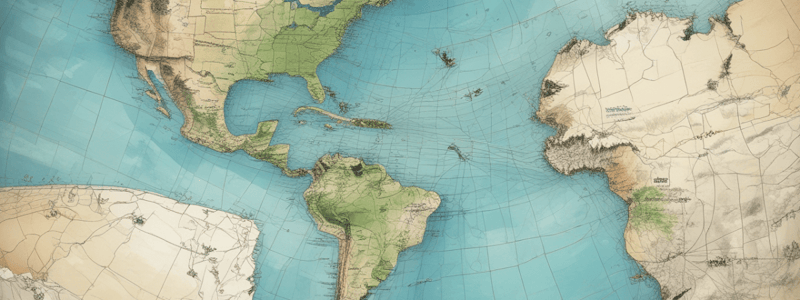Podcast
Questions and Answers
What is a primary concern for pilots when using weather maps?
What is a primary concern for pilots when using weather maps?
- Correlating information with real-time reports
- Recognizing the static nature of weather maps (correct)
- Identifying areas of high-altitude winds
- Understanding meteorological symbols
What is the primary purpose of integrating data from METARs, TAFs, and SIGMETs?
What is the primary purpose of integrating data from METARs, TAFs, and SIGMETs?
- To form a comprehensive picture of the weather (correct)
- To identify areas of high-altitude winds
- To recognize the limitations of weather maps
- To adjust altitude in real-time
What is essential for maintaining situational awareness in flight operations?
What is essential for maintaining situational awareness in flight operations?
- Knowledge of meteorological symbols
- Advanced weather map interpretation
- Continuous updates and briefings (correct)
- Understanding of atmospheric dynamics
What is a key aspect of advanced weather map interpretation?
What is a key aspect of advanced weather map interpretation?
Why is it important for pilots to be aware of jet streams?
Why is it important for pilots to be aware of jet streams?
What is the primary benefit of mastery of weather map interpretation skills?
What is the primary benefit of mastery of weather map interpretation skills?
What is a potential limitation of weather maps?
What is a potential limitation of weather maps?
What is the primary purpose of onboard weather radar systems?
What is the primary purpose of onboard weather radar systems?
What is a key component of comprehensive weather information?
What is a key component of comprehensive weather information?
Why is it important for pilots to receive continuous updates and briefings?
Why is it important for pilots to receive continuous updates and briefings?
Jet streams are typically associated with low-altitude, low-velocity winds.
Jet streams are typically associated with low-altitude, low-velocity winds.
Pilots only need to consider data from METARs when interpreting weather maps.
Pilots only need to consider data from METARs when interpreting weather maps.
Weather maps are always up-to-date and reflect real-time weather conditions.
Weather maps are always up-to-date and reflect real-time weather conditions.
Advanced weather map interpretation primarily requires knowledge of meteorological symbols.
Advanced weather map interpretation primarily requires knowledge of meteorological symbols.
Pilots only need to consider weather information when planning their route.
Pilots only need to consider weather information when planning their route.
Flight service stations do not provide continuous updates and briefings to pilots.
Flight service stations do not provide continuous updates and briefings to pilots.
Onboard weather radar systems are only used for navigation purposes.
Onboard weather radar systems are only used for navigation purposes.
Weather maps are only used by commercial aircraft pilots.
Weather maps are only used by commercial aircraft pilots.
The location of jet streams has no impact on flight time and fuel burn.
The location of jet streams has no impact on flight time and fuel burn.
Advanced weather map interpretation is only necessary for pilots operating in complex meteorological environments.
Advanced weather map interpretation is only necessary for pilots operating in complex meteorological environments.
What is the significance of jet streams in aviation, and how do they impact flight operations?
What is the significance of jet streams in aviation, and how do they impact flight operations?
What is the purpose of integrating data from METARs, TAFs, and SIGMETs in weather map interpretation?
What is the purpose of integrating data from METARs, TAFs, and SIGMETs in weather map interpretation?
What is a limitation of weather maps, and how do pilots compensate for it?
What is a limitation of weather maps, and how do pilots compensate for it?
What skills are required for advanced weather map interpretation, and how do they contribute to flight safety and efficiency?
What skills are required for advanced weather map interpretation, and how do they contribute to flight safety and efficiency?
What is the role of flight service stations in maintaining situational awareness in flight operations?
What is the role of flight service stations in maintaining situational awareness in flight operations?
What is the purpose of onboard weather radar systems, and how do they support pilot decision-making?
What is the purpose of onboard weather radar systems, and how do they support pilot decision-making?
How do pilots use weather maps to make informed decisions about route planning and altitude adjustments?
How do pilots use weather maps to make informed decisions about route planning and altitude adjustments?
What is the relationship between weather map interpretation and situational awareness in flight operations?
What is the relationship between weather map interpretation and situational awareness in flight operations?
How do pilots stay informed about changing weather conditions during flight?
How do pilots stay informed about changing weather conditions during flight?
What is the benefit of advanced weather map interpretation skills for pilots, and how do they impact flight operations?
What is the benefit of advanced weather map interpretation skills for pilots, and how do they impact flight operations?
Flashcards are hidden until you start studying
Study Notes
Navigating Weather Challenges
- Interpreting weather maps is crucial for flight planning and safety, as it enables pilots to anticipate atmospheric conditions and make informed decisions for their route.
High and Low-Pressure Areas
- High-pressure zones are marked with an "H" on weather maps and typically signal fair weather.
- Low-pressure areas are denoted by an "L" and may indicate storms and poor flying conditions.
Fronts
- Cold fronts are marked with a line with triangles pointing in the direction of movement, indicating an area where cold air is displacing warmer air, often leading to thunderstorms and heavy precipitation.
- Warm fronts, stationary fronts, and occluded fronts have distinct symbols and bring their own weather patterns, including significant changes in temperature, wind, and cloud cover.
Wind Information
- Wind speed and direction are indicated by lines with barbs called wind barbs.
- The barbs point to where the wind is going, giving pilots insights into potential headwinds, tailwinds, and crosswinds, which are vital for fuel planning and time estimation.
Precipitation and Weather Symbols
- Various notations signify rain, snow, sleet, or hail, each providing a clue to the layers of air pilots ascend through, where visibility and aircraft performance can be significantly affected.
- An open circle represents clear skies, dots represent rain, and asterisks represent snow.
Interpreting Weather Maps
- Pilots should check for high or low-pressure areas first, identify the direction of frontal systems, and always note wind information.
- Routine tips for interpreting weather maps include recognizing the language of symbols, fronts, and wind information to anticipate atmospheric conditions and make informed decisions for flight planning.
Applying Meteorological Data
- In real-world flight planning, pilots must apply meteorological data to plot a course of action in response to weather conditions.
- This involves integrating data from METARs, TAFs, and SIGMETs to form a comprehensive picture of the weather they will encounter.
Temperature and Aircraft Performance
- Temperature dramatically affects aircraft performance, including engine thrust, battery efficiency, and lift.
- Understanding the standard lapse rate and its effects on flight path is crucial.
Wind Data and Flight Planning
- Wind speeds and directions can make or break a successful take-off or landing.
- Pilots must interpret wind aloft forecasts and anticipate wind shear, which can impact in-flight stability.
Pressure Readings and Altitude Settings
- Pressure variations influence altitude settings, and pilots must recognize how to interpret barometric pressure readings on their instruments to ensure accurate altitude readings.
Charting a Course
- Crafting a well-thought-out route involves taking advantage of favorable winds and avoiding hazardous weather systems, significantly impacting fuel consumption and flight time.
Integrating Weather Information
- Pilots must correlate the information on weather maps with real-time reports and forecasts to form a comprehensive picture of the weather.
- Continuous updates and briefings from flight service stations and onboard weather radar systems are essential to maintain situational awareness.
Navigating Weather Challenges
- Interpreting weather maps is crucial for flight planning and safety, as it enables pilots to anticipate atmospheric conditions and make informed decisions for their route.
High and Low-Pressure Areas
- High-pressure zones are marked with an "H" on weather maps and typically signal fair weather.
- Low-pressure areas are denoted by an "L" and may indicate storms and poor flying conditions.
Fronts
- Cold fronts are marked with a line with triangles pointing in the direction of movement, indicating an area where cold air is displacing warmer air, often leading to thunderstorms and heavy precipitation.
- Warm fronts, stationary fronts, and occluded fronts have distinct symbols and bring their own weather patterns, including significant changes in temperature, wind, and cloud cover.
Wind Information
- Wind speed and direction are indicated by lines with barbs called wind barbs.
- The barbs point to where the wind is going, giving pilots insights into potential headwinds, tailwinds, and crosswinds, which are vital for fuel planning and time estimation.
Precipitation and Weather Symbols
- Various notations signify rain, snow, sleet, or hail, each providing a clue to the layers of air pilots ascend through, where visibility and aircraft performance can be significantly affected.
- An open circle represents clear skies, dots represent rain, and asterisks represent snow.
Interpreting Weather Maps
- Pilots should check for high or low-pressure areas first, identify the direction of frontal systems, and always note wind information.
- Routine tips for interpreting weather maps include recognizing the language of symbols, fronts, and wind information to anticipate atmospheric conditions and make informed decisions for flight planning.
Applying Meteorological Data
- In real-world flight planning, pilots must apply meteorological data to plot a course of action in response to weather conditions.
- This involves integrating data from METARs, TAFs, and SIGMETs to form a comprehensive picture of the weather they will encounter.
Temperature and Aircraft Performance
- Temperature dramatically affects aircraft performance, including engine thrust, battery efficiency, and lift.
- Understanding the standard lapse rate and its effects on flight path is crucial.
Wind Data and Flight Planning
- Wind speeds and directions can make or break a successful take-off or landing.
- Pilots must interpret wind aloft forecasts and anticipate wind shear, which can impact in-flight stability.
Pressure Readings and Altitude Settings
- Pressure variations influence altitude settings, and pilots must recognize how to interpret barometric pressure readings on their instruments to ensure accurate altitude readings.
Charting a Course
- Crafting a well-thought-out route involves taking advantage of favorable winds and avoiding hazardous weather systems, significantly impacting fuel consumption and flight time.
Integrating Weather Information
- Pilots must correlate the information on weather maps with real-time reports and forecasts to form a comprehensive picture of the weather.
- Continuous updates and briefings from flight service stations and onboard weather radar systems are essential to maintain situational awareness.
Interpreting Weather Maps
- Mastering weather map interpretation is crucial for flight planning and safety
- Understanding high and low-pressure areas: high-pressure zones (marked with "H") typically signal fair weather, while low-pressure areas (denoted by "L") may mean storms and poor flying conditions
Fronts
- Cold fronts: line with triangles pointing in the direction of movement, indicating an area where cold air is displacing warmer air, often leading to thunderstorms and heavy precipitation
- Warm fronts: lines with semi-circles or both, indicating a gradual change in temperature and precipitation
- Stationary fronts: marked by a line with both triangles and semi-circles, indicating a stationary front with little movement
- Occluded fronts: marked by a line with both triangles and semi-circles, indicating a cold front overtaking a warm front
Weather Symbols
- Clear skies: open circle
- Rain: dots
- Snow: asterisks
- Wind speed and direction: indicated by lines with barbs (wind barbs) pointing to where the wind is going
Weather Map Interpretation Techniques
- Identify high or low-pressure areas first
- Determine the direction of frontal systems
- Note wind information
- Recognize the signs of developing weather systems, such as cyclogenesis
- Understand the implications of upper-level charts, including jet streams
Importance of Weather Map Interpretation
- Enables pilots to anticipate and respond to atmospheric phenomena that can impact flight safety and efficiency
- Allows pilots to plan routes that avoid or minimize risks associated with weather events
- Helps pilots to make informed decisions for route planning, altitude adjustments, and in-flight maneuvers
Studying That Suits You
Use AI to generate personalized quizzes and flashcards to suit your learning preferences.




